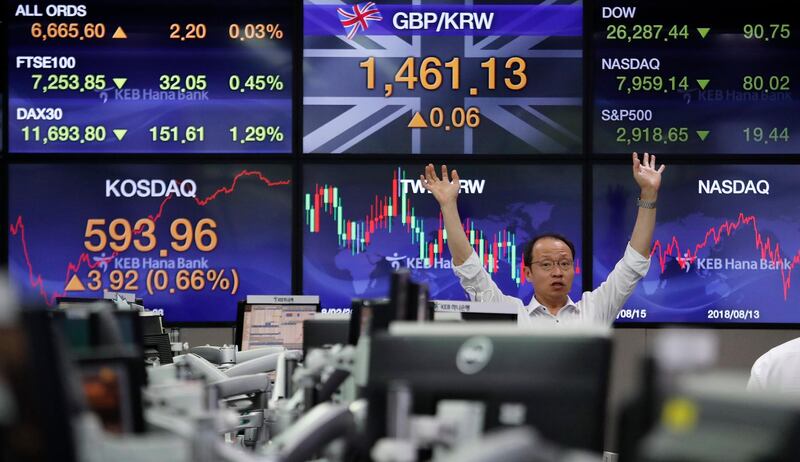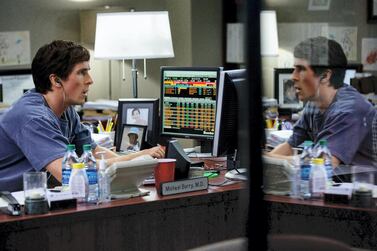Index-tracking exchange traded funds (ETFs) are enormously popular among private investors, because they offer easy access to global stock market performance at minimum cost.
They are particularly favoured by UAE residents, because they are cheap and easy to buy on an online trading platform, and combine rock bottom charges with maximum flexibility, as you can buy and sell them at any time.
The biggest stumbling block is that there are literally thousands to choose from, and they don't always have
consumer-friendly names. Choice is a wonderful thing, but sometimes you can have too much of it, making it difficult to work out which ones are the best to buy.
You could make things really simple for yourself, by purchasing Vanguard FTSE All-World ETF (VWRD), a one-stop shop fund that is hugely popular among members of SimplyFI, a non-profit community of personal finance and investing enthusiasts in the Emirates.
This ETF gives you access to around 3,000 different companies in nearly 50 countries worldwide, in both developed and emerging markets, and has an annual charge of just 0.22 per cent.
If you want some exposure to bonds, you can pair it up with the iShares Global Govt Bond UCITS ETF (IGLO).
However, given the massive ETF multi-verse, many will be reluctant to limit themselves in this way, so we asked our investment experts to select some of their favourites.
Before rushing to buy, though, Ben Barber, a UAE financial blogger at www.buildingwealthwisely.com, advises checking what funds you already hold.
“Any new fund purchase should balance your existing portfolio," says Mr Barber, "to give you a balanced spread across different countries, markets and sectors.”
iShares Core S&P 500 UCITS ETF (CSPX)
Aim: To track the performance of the top 500 US large cap US-based companies and multinationals.
Fund size: $36 billion (Dh132.23bn)
Number of holdings: 500
Annual yield: 1.88 per cent
Annual charges: 0.07 per cent
Analysis: Sam Dickens, portfolio manager at trading platform IG, says this ETF gives you exposure to many of the most successful companies in the world. “You can also have currency hedged versions, for example, GSPX is hedged against the British pound, which may appeal to UK investors.”
VanEck Vectors India Small-Cap Index ETF (SCIF)
Aim: To replicate the price and yield performance of the MVIS India Small-Cap Index, which covers companies either based in India or with at least 50 per cent of their revenue or assets in the country.
Fund size: $126 million
Number of holdings: 170
Annual yield: 0.61 per cent
Annual charges: 0.83 per cent
Analysis: Vijay Valecha, chief market analyst at Century Financial Brokers in Dubai, who tipped this fund, says India's consumption-based economy is a great way to ride emerging market growth. “It enjoys relative safety from the global trade war, while local small caps are likely to benefit from the structural reforms like lowering of corporate taxes and central bank easing.”
Vanguard FTSE All-World UCITS ETF (VWRD)
Aim: This ETF seeks to provide long-term capital growth from tracking the performance of the FTSE All World Index, which covers large and mid cap companies in developed and emerging countries.
Fund size: $3.2bn
Number of holdings: 2,900
Annual yield: 2.03 per cent
Annual charges: 0.22 per cent
Analysis: Steve Cronin, founder of DeadSimpleSaving.com, a non-profit site helping people invest their money sensibly by themselves, said this could be the only stocks and shares fund you ever need. "Invest every month like clockwork in this cheap, globally-diversified passive stock index tracker, then get on with your life."
iShares Edge MSCI World Size Factor UCITS ETF (IWSZ)
Aim: To provide both income and capital growth from small and medium-sized companies around the world, by tracking performance of the MSCI World Mid-Cap Equally Weighted Index.
Fund size: $700 million
Number of holdings: 914
Annual yield: Zero
Annual charges: 0.30 per cent
Analysis: The fund is a third invested in the US, with sizeable exposure to Japan, the UK, Canada, France, Australia and Germany. Mr Dickens says: “This gives you weighted exposure to a wide spread of global mid-cap stocks offering plenty of diversification.”
VanEck Vectors Gold Miners UCITS ETF (GDX)
Aim: This ETF that if you access to the performance of gold mining stocks by following New York’s NYSE Arca Gold Miners Index (GDMNTR).
Fund size: $239m
Number of holdings: 45
Annual yield: Zero
Annual charges: 0.53 per cent
Comment: Mr Valecha says near-zero and negative interest rates make now a good time to invest in gold. The precious metal doesn't pay any interest, but that is less of a problem if returns elsewhere are so low. Gold doesn't correlate with stock markets, and therefore gives some protection against a crash.
UBS ETF — MSCI EMU Socially Responsible UCITS ETF (IB39)
Aim: To track the MSCI EMU Socially Responsible 5 per cent Issuer Capped Index, which is made up of socially responsible eurozone companies with relatively high environmental, social and governance ratings.
Fund size: $1.3bn
Number of holdings: 60
Annual yield: 2.48 per cent
Annual charges: 0.28 per cent
Analysis: This Luxembourg-domiciled fund will appeal to those who want exposure to Europe via ethical, socially responsible companies. UBS ETF has outperformed strongly lately but Mr Dickens says: “Be warned, SRI investments will not always outperform.”
WisdomTree Emerging Markets Equity Income UCITS ETF (DEM)
Aim: To provide exposure to a spread of dividend-paying emerging market stocks, by tracking the WisdomTree Emerging Markets High Dividend Index.
Fund size: $47m
Number of holdings: 500
Annual yield: 4.3 per cent
Annual charges: 0.47 per cent
Analysis: This ETF offers large exposure to Taiwan, China and Russia, plus emerging markets including South Africa, Hong Kong, Brazil, South Korea and India. Mr Dickens says: “Emerging markets have been treading water lately, so it makes sense to invest in high-quality companies with a proven ability to pay and raise dividends.”
iShares USD Treasury Bond 20+ year UCITS ETF (IDTL)
Aim: This ETF seeks to track the performance of an index composed of US dollar-denominated government bonds, issued by the US Treasury, running for 20 years or longer.
Fund size: $693m
Number of holdings: 40
Annual yield: 2.45 per cent
Annual charges: 0.07 per cent
Analysis: Mr Dickens is cautious about the global economy right now, and if economic data continues to worsen the US Federal Reserve could cut interest rates still further. “If this happens, then a bet on longer maturity bonds could do well, by giving you access to higher yields.”
Invesco S&P Global Water Index ETF (CGW)
Aim: This ETF tracks the S&P Global Water Index, primarily developed stocks securities including water utilities, infrastructure, equipment and materials companies.
Fund size: $733 million
Number of holdings: 50
Annual yield: 1.69 per cent
Annual charges: 0.62 per cent
Analysis: Mr Valecha says water is an essential part of our daily lives and with world population burgeoning, demand is only going to rise. “This fund will help capture the trend.”
iShares Global Financials ETF (IXG)
Aim: This ETF tracks the investment results of an index composed of global equities in the financial sector.
Fund size: £297m
Number of holdings: 193
Annual yield: 2.80 per cent
Annual charges: 0.46 per cent
Analysis: This ETF is roughly 50 per cent invested in the US, but with exposure to Canada, the UK, Australia, Japan, China, Switzerland and other countries. Mr Valecha says the financial sector is the cornerstone of any economy. “Stringent regulations introduced after the 2008 financial crisis make it less susceptible to another breakdown.”
iShares Global Tech ETF (IXN)
Aim: Gives investors targeted access to technology companies around the world by tracking an index composed of global equities.
Fund size: $3bn
Number of holdings: 116
Annual yield: 1.02 per cent
Annual charges: 0.46 per cent
Analysis: Mr Valecha says technology is transforming the world. “This is only the beginning of a new era, and this ETF is perfectly suited to exploit this theme.”









